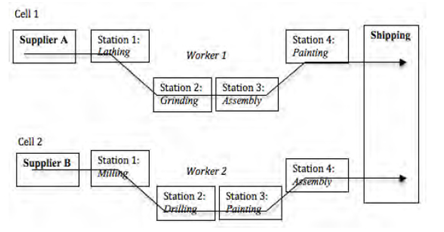Supply chain management is the business function that coordinates and manages all the activities of the supply chain, including suppliers of raw materials, components and services, transportation providers, internal departments, and information systems. Below figure illustrates a supply chain for providing packaged milk to consumers.

In the manufacturing sector, supply chain management addresses the movement of goods through the supply chain from the supplier to the manufacturer, to wholesalers or warehouse distribution centers, to retailers and finally to the consumer. For example, Apple, Inc uses sophisticated information systems to accept orders for custom-built computers from individual customers all over the world. Apple assembles the computers in Shanghai, China, to the customers’ specifications. It uses parts and components that are provided by outside suppliers who can deliver the right parts in the right quantity in a timely way to satisfy the immediate production schedule. The completed computers are flown from Shanghai by FedEx, reaching the end-user customers only a few days after the orders were placed. Apple’s supply chain allows it to provide fast delivery of high-quality custom computers at competitive prices.
Supply chain concepts also apply to the service sector, where service firms must coordinate equipment, materials, and human resources to provide services to their customers in a timely manner. For example, a retail store that sells electronic products may contract with an outside business to provide installation services to its customers. In many cases, the customer does not even know the installation was done by an outside contractor. Information and communication technologies such as global positioning systems (GPS), barcode technology, customer relationship management (CRM) databases, and the Internet allow service businesses to coordinate external and internal service suppliers to efficiently and effectively respond to customer demand.
The supply chain is not just a one way process that runs from raw materials to the end customer. Although goods tend to flow this way, important data such as forecasts, inventory status, shipping schedules, and sales data are examples of information that is constantly being conveyed to different links in the supply chain. Money also tends to flow “upstream” in the supply chain so goods and service providers can be paid.
Basic components of SCM
- Plan – Every company needs a strategy on how to manage the resources in order to achieve their customers demand for their products and services. The supply chain management is developing a set of metric to monitor the supply chain so that it can deliver high qualities and values to customers.
- Source – To create their products, companies need to be very careful when choosing suppliers to deliver their goods and services needed. The managers need to develop a set pricing and delivery system in the supply chain. They can also put processes for managing their goods and goods inventory, for example; receiving shipments.
- Make – In manufacturing the supply chain manager should always schedule the activities that are needed for the production, packaging, testing and preparation for delivery. The most metric-intensive portion of the supply chain, production output and measure levels.
- Deliver – This part is mainly referred to as logistics by the supply chain management. In this case companies coordinate receipts of orders, pick carriers to get products to customers and develop a network of warehouses.
- Return – In many companies this is usually where the problem is – in the supply chain. The planners should create a flexible and responsible network for receiving a flaw and excess products sent back to them (from customers).

